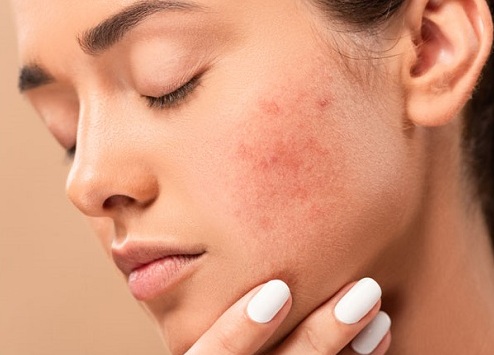
The signs and symptoms of acne depend on the severity of the acne condition. The following are some common types of acne that affect many individuals:
Whiteheads are closed, clogged comedones on the skin. These are small, white-colored bumps or spots. They appear like white, circular spots surrounded by a red halo. Whiteheads do not cause the formation of scars.
Blackheads are open, clogged comedones on the skin. They appear as small, black-colored spots. The center of blackheads appears darker than the skin around it. Blackheads are formed when whiteheads get in contact with dust, air, and dead cells.
Papules or skin lesions are small, tender, and red bumps present on the surface of the skin. The skin around papules appears slightly red and swollen. Papule is formed due to bacterial invasion, and excess activity of androgen. It does not have pus-filled in it, when it accumulates pus it becomes a pustule.
Pustules are papules in which pus is present at their tips. These are tender, larger bumps with a circular centre. Whitish and yellowish pus is present inside their centre. Bacterial cells invade such centres and make the condition more severe.
Nodules are present deep inside the skin and appear large, solid, and painful lumps. When clogged pores damage cells and tissues present deep inside the surface of the skin they form nodules. Nodules are a severe form of acne that can lead to forming scars and dark spots. Cystic lesions are very large, pus-filled, and painful lumps present deep inside the surface of the skin. Cysts are a more severe form of acne that can lead to deep scars.
Main factors that cause acne
Excess oil production
Hair follicles that are clogged by oil and dead skin cells
Bacteria
Excess activity of androgen hormone
PCOD/PCOS
Medications/drug induced
Genetics
Various factors can cause acne, and a skin specialist or a dermatologist is the best person to determine the root cause of acne. It can be easily treated once the cause is known.
Many people try to treat acne using products available at drug-stores and trying home remedies, but this can worsen acne, and leaves the skin with acne scars. However, in critical acne conditions consulting dermatologists is important. Dermatologists provide medicines, surgery and therapies to help fight acne by ensuring clear and scar-free skin.
Acne treatment
Medical treatment is always a first line therapy for acne and post acne pigmentation, however depending on the response to treatment and severity of lesions various other modalities can be added to the therapy. Here are some of the treatments which are recommended
1. Chemical Peel: Many types of chemical peels are designed for acne and post acne pigmentation such as salicylic acid peel, black peel, glycolic peel, TCA, and many more. The type of chemical peels used should be according to the severity of acne and acne scars. Chemical peels not only hasten the treatment but also help the medicated creams to penetrate deep, ultimately giving a smoother and even tone to the skin.
2. Comedone Extraction: Dermatologists can remove comedones such as whiteheads and blackheads by using specialized instruments. In this treatment, gentle pressure is applied around the pore opening to extract blackheads, and incision with a blade or large needle is used to extract whiteheads.
3. Medifacials: Medifacial is more effective than other ordinary facials because of its composition. In medifacials, medical-grade products are used to cleanse the skin and remove impurities. These facials can be customized as per the patient's skin. This can help in reducing oil production and unclog the pores. It renews the skin by penetrating the skin’s layers and gives a long-lasting effect to the skin.
4. Carbon Laser Peel Treatment(HOLLYWOOD PEEL): It is highly effective for skin problems like acne, oily skin, comedones, dull skin, and enlarged pores on the skin. This treatment makes the skin softer, smoother and nourished. In this treatment, liquid carbon is applied to the skin that penetrates deep inside the skin pores. Carbon particles attract laser light and destroy the carbon, including dead skin cells, oil, bacteria, and contaminants. Carbon peel treatment kills the acne producing bacteria. It also improves the production of collagen deep inside the skin layers. Thus, carbon peel is the best treatment not only for acne but acne scars as well.
Prevention
. Wash your face no more than twice each day with warm water and a mild soap made especially for acne.
. Do not burst the pimples by scrubbing the skin.
. Wash your hands regularly by applying lotions, creams, or makeup.
. Wear loose clothing to let the skin breathe, if the acne is present on the back, shoulders, or chest.
. Avoid excessive sun exposure.
. Avoid anxiety and stress.
. Clean your hair regularly, as it collects sebum and skin residue.